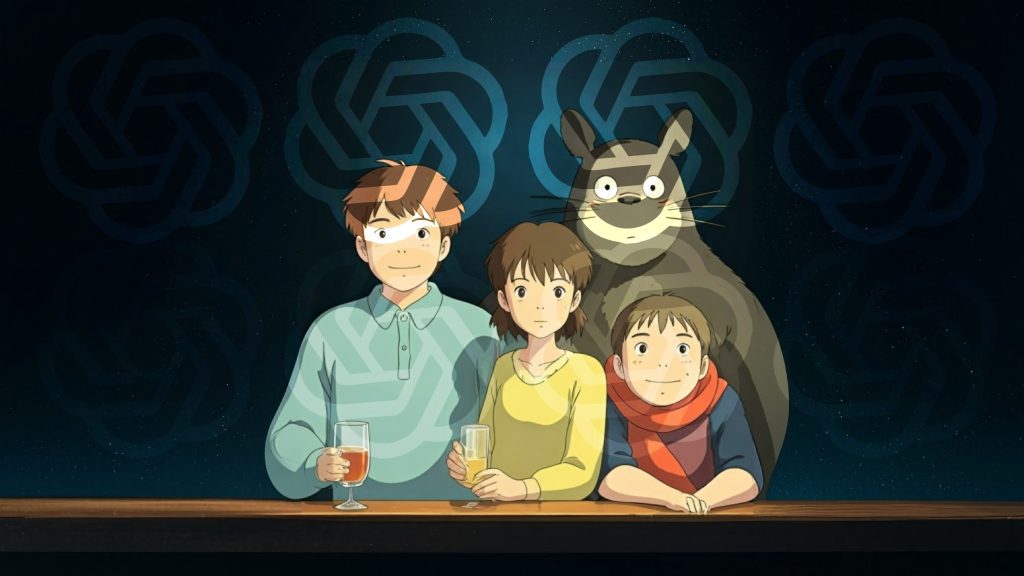
The magic, the charm, the whimsical universe of Ghibli studio dreamscape is now just one click away, where you just need to upload a selfie, and there you have it, you are now a rosy-cheeked, wide eyed-wanderer of a Studio Ghibli art style.
Who wouldn’t want to be spirited away into a world of soft colors and breezy winds? Yet, somewhere, somehow, the dark shadows of the world have managed to infiltrate the world’s most beloved Japanese animation studio, lurking behind the curtains of a delightful AI-fantasy.
The internet has fallen in love with Studio Ghibli animation style AI generated portraits, with users gleefully churning out Ghibli-fied portraits, but one person uncovered the truth behind this widespread trend.
The Studio. The Trend. Data Mining.
The godfather, the iconic founder of Studio Ghibli, Hayao Miyazaki, who isn’t a fan of AI demos, is not really fascinated by the latest trend stripping the very soul of his creations. OpenAI’s data-hungry machines are feasting on the buffet of biometric gold, all due to the newly created Studio Ghibli art style trend.
Millions are uploading their selfies to OpenAI’s ChatGPT’s new image generator, watching themselves transform into adorable AI art generator of Studio Ghibli characters similar to Miyazaki’s films. As these images go viral, there’s a deeper issue quietly taking place, what exactly happens to our data once it’s processed? That means your face, your likeness, and even your artistic preferences could become part of the next generation of AI intelligence.
Every sparkly-eyed transformation, wistful smile, every just one more! click is another tasty morsel for AI’s every-growing appetite to mine more data. The truth of the matter is that, sure, you can opt-out, but when it comes to Hayao Miyazaki filter, some users are not really thinking about privacy, making the trend even far more dangerous.
If you’re using GPT here are the following steps:
- click on your profile picture
- select setting Settings > Data Controls
- switch off “Improve the model for everyone” – most people aren’t aware that their data is being sent to a massive learning machine.
Ghibli Images Spark Outrage
The dangerous kawaii twist? Well, it’s not really the Studio Ghibli style art generator, it’s the military getting in on the aesthetic charm offensive.
The whole trend took a darker turn when the Israel Defense Forces (IDF) hopped on the Ghibli style art generator trend, posting AI-generated images of its soldiers bathed in the signature Studio Ghibli art style in soft, pastel tones, representing various branches of its military.
“We thought we’d also hop on the trend,” the caption read.
The backlash was instant.
IDF’s delusionary approach of bathing their soldiers with the signature Studio Ghibli art style glow, of soft watercolor skies, dreamy pastel uniforms, and the delusional air of wistful heroism, has pushed critics to express fuming anger at IDF’s post, saying it’s nothing but a mere attempt to whitewash the image of an army deeply ingrained in a war that has displaced and destroyed millions of Palestinians, as well as Lebanese.
Others criticized the hypocrisy of appealing to the Studio Ghibli AI art generator aesthetic, which is famously known for peaceful feelings to symbolize its stand against military power. Back in 2016, Miyazaki was seen in a video back disdaining and stating that he was “utterly disgusted” after seeing the AI demo.
Let’s not forget, every one of those AI-generated soldiers and civilian portraits likely fed right back into the same data-hungry machine that’s already mining civilian selfies for profit, or more dangerously and ethically corrupted, mining selfies for the death machine.
AI Trained on Faces to Wage Endless Wars
If OpenAI trains its models users’ uploaded images, it’s also using content uploaded by state militaries like the IDF’s Studio Ghibli art style aesthetic photos into its training loop, as these models aren’t just learning to copy, in this case, its learning to beautify and whitewash the ongoing silent wars by Israel.
It’s not just a matter of privacy of data, but one of control over global narratives, and AI’s potential to be trained on artificial photos of war questions the nature of how machines will view war, power, and geopolitics in the future.
With increasing concern over the AI art generator of Studio Ghibli trend on OpenAI and the fact that its using images to train its, will the Trump administration mark it as an invasion towards privacy and security concerns, or does this only happen the company is non- American?
Real Picture Behind Studio Ghibli Art Style
This is no longer a story of cartoon selfies or AI art trends. It’s about the real cost of letting AI systems train off of the images we post and information that we ask GPT. These images are rebranding humans and rebranding the idea of war by making it have a cartoon like appeal which makes the images softer for the human to see.
When war propaganda, popular culture, and advanced algorithms come together, we risk creating systems that normalize war. By giving pictures of contaminated military might to AI algorithms, we run the risk of teaching machines a distorted history where blood is lovely, context is stripped away, and suffering is erased.
What we publish today might control how tomorrow AI perceives the world. Creators, users, as well as legislatures today have to be strict about insisting on openness and ethical boundaries. Large language machines are learning from us, and we are molding them either for the better or to the worse, hence why nothing in the media is real and there is no authenticity. We should learn to be careful regarding trends such as the latest generated Ghibli art style one as we can build this world into a better one or burn it down slowly.
Inside Telecom provides you with an extensive list of content covering all aspects of the tech industry. Keep an eye on our Intelligent Tech sections to stay informed and up-to-date with our daily articles.